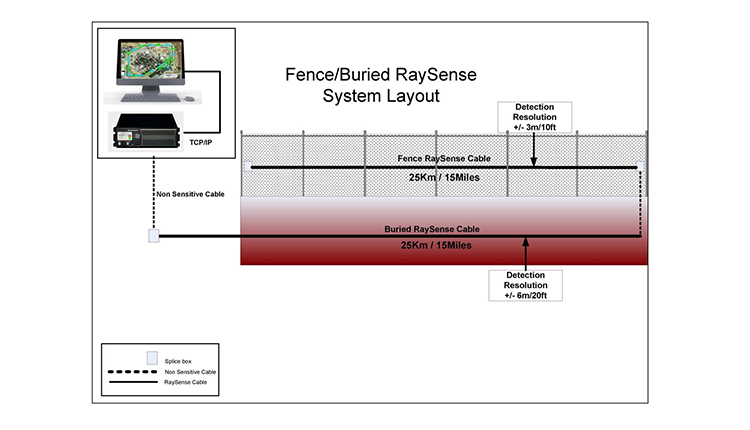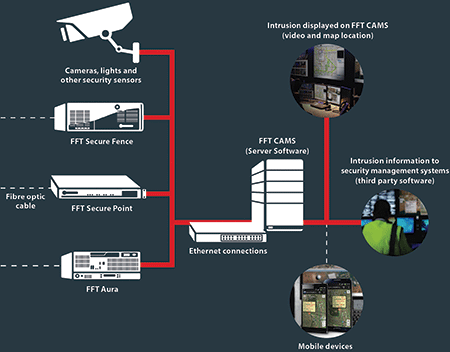Secure Your Residential Or Commercial Property With Reliable Fiber Optic Protection Solutions
In an age where security dangers are increasingly advanced, the demand for effective defense solutions is vital. Fiber optic security systems stick out by supplying outstanding reliability and performance, leveraging innovative light transmission technology to improve security capabilities. These systems not only supply resistance to electromagnetic interference however additionally assure lasting cost efficiency with minimized upkeep requirements. Nevertheless, the choice to purchase such a solution involves cautious factor to consider of various aspects. Comprehending the ins and outs of fiber optic protection can illuminate the path to protecting your residential property better. What aspects should be explored to optimize your financial investment?
Advantages of Fiber Optic Security
Fiber optic protection options provide a series of benefits that make them significantly necessary in today's digital landscape. Among the most significant advantages is their exceptional data transfer capability, which enables the transmission of huge amounts of information over cross countries without considerable signal degradation. This capacity is particularly useful for safety systems that count on high-def video monitoring and real-time monitoring.
In addition, fiber optic cables are naturally more safe and secure than conventional copper circuitry. They are immune to electro-magnetic interference, making them less at risk to hacking or eavesdropping. This improved protection is important for shielding sensitive information and maintaining the stability of security systems.
Furthermore, optical fiber are much more resilient and immune to ecological elements, such as wetness and temperature level fluctuations, ensuring long-term reliability and decreased upkeep prices. The lightweight nature of fiber optic cords additionally streamlines installation processes, permitting better adaptability in system style.
Just How Fiber Optic Systems Work
In modern security applications, the procedure of fiber optic systems depends on the concepts of light transmission with flexible glass or plastic fibers. These fibers are designed to lug light signals over lengthy ranges with very little loss, making them optimal for transferring data associated with security surveillance. The core of the fiber, bordered by a cladding material, ensures that light signals continue to be consisted of within the core through a phenomenon called overall internal representation.
When incorporated into protection systems, fiber optic cords can transfer information from different sensors, such as electronic cameras, movement detectors, and alarms, to a main surveillance terminal. The high bandwidth ability of fiber optics permits for the transmission of big amounts of information at the same time, enabling real-time monitoring and prompt feedback to prospective threats.

Kinds Of Fiber Optic Security Solutions
Numerous sorts of fiber optic safety and security solutions have actually emerged to improve surveillance and defense across various environments. One popular solution is fiber optic boundary breach detection systems (PIDS), created to keep track of and safeguard property limits via the detection of resonances and disruptions along fiber optic cables. These systems supply real-time alerts, allowing prompt reactions to unapproved accessibility attempts.
One more reliable solution is fiber optic video monitoring. This modern technology leverages high-definition video cameras linked using fiber optic cables to transfer video clip data over cross countries without considerable loss of quality. This configuration is particularly advantageous in expansive locations, such as flight terminals and commercial websites, where typical copper wires may falter.
Furthermore, fiber optic sensors are significantly made use of for ecological surveillance, spotting modifications in temperature level, stress, or acoustic signals that can show security violations or hazardous problems. These sensing units supply high level of sensitivity and precision, making them excellent for critical infrastructure protection.

Setup and Upkeep Tips
Efficient setup and maintenance of fiber optic protection remedies are critical for guaranteeing their optimum efficiency and durability. To begin with, it is important to plan the installation meticulously, taking into consideration the design of the residential property and determining potential vulnerabilities. Fiber optic cable televisions should be transmitted firmly, preventing sharp bends or twists that can jeopardize their integrity. Use professional-grade ports and rooms to ensure durable connections and defense from ecological aspects.
Throughout setup, it is advisable to perform comprehensive screening of the system to verify that all parts are functioning appropriately. Regular upkeep checks should be arranged to inspect the fiber optic cords for any kind of indications of wear or damages, in addition to to make certain that connections stay secure. Cleaning up the adapters periodically is likewise essential to avoid signal loss as a result of dust or debris.
In addition, keeping an upgraded inventory of set up parts and their specifications can assist in less complicated troubleshooting and upgrades. By adhering to next page these setup and upkeep pointers, homeowner can take full advantage of the efficiency of their fiber optic safety and security options, making certain a reputable protection versus potential risks.
Comparing Expenses and Efficiency
When reviewing fiber optic protection solutions, understanding the balance between costs and effectiveness ends up being critical (security fibers). Organizations needs to think about the ahead of time financial investment, recurring upkeep costs, and the long-lasting value these systems supply. why not check here While fiber optic systems might require a higher initial installment price compared to typical copper electrical wiring, their sturdiness and decreased susceptibility to electro-magnetic disturbance usually convert to lower maintenance costs with time
Efficiency is another vital factor; fiber optic safety and security systems supply boosted information transmission speeds and enhanced reliability. They can cover larger distances without signal destruction, making them ideal for large buildings or remote places. Additionally, the high data transfer capability sustains innovative safety applications, such as high-definition video security and real-time tracking, which are essential for detailed security monitoring.
Inevitably, the choice in between price and efficiency must be assisted by details safety demands and risk assessments. Organizations should analyze their one-of-a-kind requirements, thinking about aspects like building dimension, security hazards, and technological improvements. By conducting a comprehensive cost-benefit analysis, stakeholders can make enlightened decisions that straighten with their security objectives while making sure an audio investment in fiber optic innovation.
Conclusion
Finally, fiber optic protection services supply substantial advantages in regards to efficiency, reliability, and immunity to ecological interferences. These systems boost surveillance capabilities and perimeter safety and security, making them an effective choice click to read for thorough protection. Although initial installment prices may be greater, the long-lasting advantages, consisting of reduced upkeep and superior capability, validate the financial investment. Ultimately, the fostering of fiber optic innovation stands for a forward-thinking approach to protecting residential or commercial properties against developing security dangers.